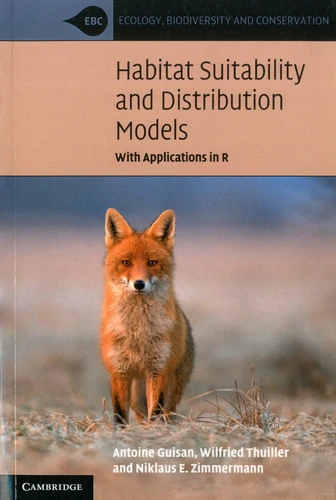Habitat Suitability and Distribution Models. With application in R
Par : , ,Formats :
- Paiement en ligne :
- Livraison à domicile ou en point Mondial Relay indisponible
- Retrait Click and Collect en magasin gratuit
- Réservation en ligne avec paiement en magasin :
- Indisponible pour réserver et payer en magasin
- Nombre de pages462
- PrésentationBroché
- FormatGrand Format
- Poids0.81 kg
- Dimensions15,2 cm × 22,7 cm × 2,5 cm
- ISBN978-0-521-75836-9
- EAN9780521758369
- Date de parution01/09/2017
- CollectionEcology, Biodiversity and Cons
- ÉditeurCambridge University Press
- ContributeurValeria Di Cola
Résumé
This book introduces the key stages of niche-based habitat suitability model building, evaluation and prediction required for understanding and predicting furore patterns of species and biodiversity. Beginning with the main theory behind ecological niches and species distributions, the book proceeds through all major steps of model building, from conceptualization and model training to model evaluation and spazo-temporal predictions.
Extensive examples using Rsupport graduate students and researchers in quantifying ecological niches and predicting species distributions with their own data, and help to address key environmental and conservation problems. Reflecting this highly active field of research, the book incorporates the latest developments from informatics and statistics, as well as using data from remote sources such as satellite imagery.
Awebsite at www.unil.chlhsdm contains the codes and supporting material required to run the examples and teach courses.
Extensive examples using Rsupport graduate students and researchers in quantifying ecological niches and predicting species distributions with their own data, and help to address key environmental and conservation problems. Reflecting this highly active field of research, the book incorporates the latest developments from informatics and statistics, as well as using data from remote sources such as satellite imagery.
Awebsite at www.unil.chlhsdm contains the codes and supporting material required to run the examples and teach courses.
This book introduces the key stages of niche-based habitat suitability model building, evaluation and prediction required for understanding and predicting furore patterns of species and biodiversity. Beginning with the main theory behind ecological niches and species distributions, the book proceeds through all major steps of model building, from conceptualization and model training to model evaluation and spazo-temporal predictions.
Extensive examples using Rsupport graduate students and researchers in quantifying ecological niches and predicting species distributions with their own data, and help to address key environmental and conservation problems. Reflecting this highly active field of research, the book incorporates the latest developments from informatics and statistics, as well as using data from remote sources such as satellite imagery.
Awebsite at www.unil.chlhsdm contains the codes and supporting material required to run the examples and teach courses.
Extensive examples using Rsupport graduate students and researchers in quantifying ecological niches and predicting species distributions with their own data, and help to address key environmental and conservation problems. Reflecting this highly active field of research, the book incorporates the latest developments from informatics and statistics, as well as using data from remote sources such as satellite imagery.
Awebsite at www.unil.chlhsdm contains the codes and supporting material required to run the examples and teach courses.


